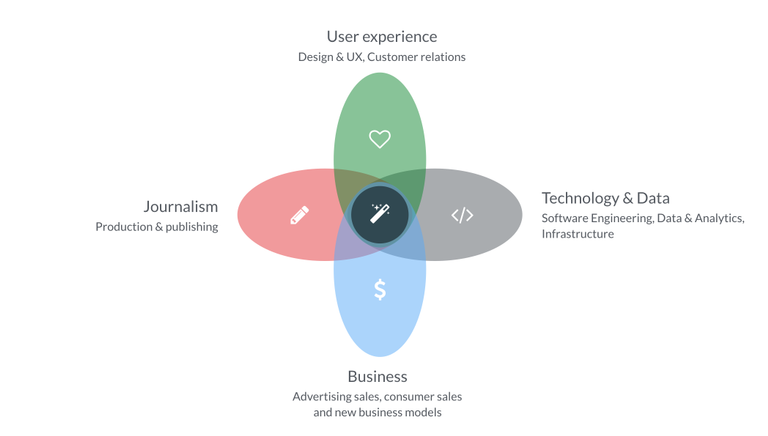
Our top tips to ace your Awards entry
You’ve done the hard work – now you’re only a few simple steps away from industry recognition.
PPA Blog
PPA Blog
Publishers of all shapes and sizes are facing an increasingly competitive environment.
Young startups can cheaply leverage the democratising features of the internet to reach an audience at scale. In fact, a sole blogger or YouTuber in his or her bedroom can break news or offer a unique opinion in virtually any niche (think Ben Thompson of Stratechery).
On the opposite side, some of the largest publishers in the world – like The New York Times – have recognised how critical it is to embrace a change.
I think publishers are also beginning to recognise that there is a new must-hire in order to remain competitive. This must-hire is ubiquitous in all types of technology startups. That said, publishers have hesitated to recruit and hire these individuals.
We are talking about the product manager. Product managers have become increasingly important for the future of all publishers.
But why is this so now?
The product manager role simply didn’t arrive out of thin air. In fact, product managers have existed for many decades.
However to start, we must first settle on what we mean by the term digital product.
What is a Digital Product?
So generally speaking, a digital product is “a software-enabled product or service that offers some form of utility to a human being.”
These products or services deliver a solution to a problem that your customer or audience faces. Put another way, a digital product is a collection of digital features and functions that improve your users’ lives.
According to the above definition of a digital product, naming some is fairly easy. A mobile app like Instagram or even digital courses on MasterClass are digital products or services that create value. They also solve problems in users’ lives.

A digital course on MasterClass is a digital product.
But in the publishing space, this expansive definition of digital product is more interesting.
This conversation would be different several decades ago. The product would simply be a newspaper, a radio broadcast, or a television broadcast.
This definition has changed with the rise of the internet and the digital economy. Here, a digital product in the publishing space encompasses a wide range of things. For instance, interactive stories can be digital products. They can also be bots (like the Quartz App) that connect readers with news.
In sum, in the publishing space, the digital product umbrella contains many of the tools and applications that inform, entertain, or notify readers.
The Origins of Product Management

Neil H. McElroy
From the definition of a digital product, let’s talk about product management.
Product management isn’t a brand new concept.
In fact, the idea of product management emerged in 1931 at Procter & Gamble. Neil H. McElroy’s famous 800-word memo outlined the responsibilities of product managers at P&G.
These responsibilities included tracking sales, advertising and promotions, and managing the product. Ultimately, McElroy helped transform P&G into a brand-centric organisation and made the product manager adopt the internal voice of the customer.
While this idea of product management certainly helped P&G prosper, it didn’t exactly spread like wildfire.
The widespread use of product management, however, would occur with the impressive rise of one industry.
What industry? The technology industry.
Product Management in Tech
The product manager today is most recognised in the offices of tech startups. You can find them at internet giants like Google and at rapidly growing startups.
Product managers from the P&G era were part of an organisation’s marketing function. The same is true of product managers in the fast-moving consumer goods industry today.
Nonetheless, this is not the case in the technology industry. Product management in tech isn’t solely a marketing communications role. Instead, it is tied to the development and the production of the product itself.
In the technology space, product managers cannot simply rely on the messaging, pricing, or even packaging of a commodity to succeed.
Instead, product managers in technology must be agile. They must have a deep understanding of customers and their needs. These needs may not necessarily be static.
In fact, this emphasis on agility was memorialised through the Agile Manifesto, which provides foundational principles on why product managers should focus on customers rather than off-the-mark deliverables from the C-suite.
Along with this, the product manager in technology is essentially a mini-CEO. He or she wears many hats. They bring together cross-functional teams to build and update products.

Source: McKinsey & Company
Therefore, the product manager in technology, among other things, must collect and analyse data, iterate frequently, identify key partnerships, and manage the developer ecosystem. Throughout it all, speed to market is a critical factor for success.
The need for Project Management in Media
Product managers are increasingly vital because the inherent nature of publishing is more complicated.
An ordinary publisher, for instance, may have multiple websites for desktop and mobile devices. They may have more than one digital video operation. They may have a subscription options and several apps. They may even have more than one advertising product that requires regular updates.
Publishers now run highly complex businesses. The paradigm has shifted. Publishers just can’t generate content, release it on their website, and wait for traffic.
Instead publishers have some heavy lifting ahead.
“For most publishers, generally speaking, there is still quite a ways to go.”
Anita Zielina, Visiting Fellow at Reuters Institute and former chief product officer at Neue Zürcher Zeitung Media
Essentially, the product manager role has become increasingly important inside media companies.
Once again, product management connects the organisation’s products to its mission and values. While product management in the 20th century focused on sales, promotion, and distribution, product management in today’s digital economy more closely aligns with customer needs.
In the era of digital content, media companies have virtually no barriers to their audience.
The culture within media organisations, for the most part, needed to change to leverage these connections. It also needed to change to leverage the tools to build those connections.
“Unless media companies step it up and totally change their view and abilities on product management, they will be eaten by tech and new players.”
Espen Sundve, Chief Product Officer at Kolonial.no
Sundve argues that those who work at media companies need to prioritise one important thing. They must find product managers who can successfully bridge the gap between journalism and technology.
These product managers should be responsible for setting content and product strategy, prioritising what to write and build next, and executing to ensure great content, design, and that code is shipped.
If a media organisation is rather small and is considering shifting traditional editorial roles to more product management-centric roles, more work is needed. These newly-converted product managers need to quickly become comfortable with this narrow intersection between journalism, user experience, technology, data and business.
Large media companies have already started to dive in.
For instance, Bloomberg Media hired its first digital head of product. She will oversee products like Bloomberg’s desktop and mobile site. Similarly, Vox Media now has 10 product managers. The Washington Post has tripled the number of product managers that it employs.

Ultimately, according to Eddie Koller III, a managing partner at Koller Search Partners, a big headhunting firm, “there’s a huge demand” for product managers in media organisations.
Rethink Product Management
The role of the product manager, as referenced above, is expanding.
Not only must key decision makers understand the importance of the product manager, but they should provide product managers with autonomy and then step away.
To sum it up, less attention should be paid to organisational culture and the “publish when perfect” mindset. Instead, product managers in publishing should test often and emphasise speed. The internet and digital technologies incentivise speed and iteration.
Therefore, product managers should leverage these benefits – even if they feel somewhat unnatural in the publishing world.
Even more important: instead of a focus on results, product managers within publishing should focus on the process.
Within that process, publishing organisations should emphasise rigorous research and data. Relying on hunches or intuitions about what the audience really wants is often less effective than going to the data and seeing how your audience is actually behaving.

Critical success factors for product management in media.
Source: Venn diagram by Espen Sundve
Granted, being an absolute slave to the data is never wise. A healthy amount of nuance is helpful here, as sometimes product managers can have accurate intuitions that simply aren’t present in the data.
Nevertheless, data is the north star that absolutely deserves the attention of all product managers at publishers and media organisations.
Conclusion
The increased importance of the product manager has existed for some time. That said, this need isn’t static.
Even if your media organisation has already embraced the product manager revolution – you can always improve. And if you haven’t yet joined the party, you should certainly do so.
We are living in an exciting period of technological progress and disruptive innovation.
To better connect with their audiences, publishers have many game-changing tools at their fingertips. These tools can help publishers build authentic relationships with their audiences.
Therefore, to properly leverage these tools, publishers must invest in product managers. By doing so, publishers will be more likely to accomplish not only their editorial goals, but their financial goals as well.
Also, if you want to learn more about “How Amazon Polly is changing the publishing industry”, watch our free webinar here.
This article was first published at purplepublish.com

You’ve done the hard work – now you’re only a few simple steps away from industry recognition.

Denmaur Independent Papers has announced it has finalised the purchase of the business and assets of the Fine Paper and Conversion division from Middleton Paper Company Ltd.
Chancery House, 53-64 Chancery Lane, London WC2A 1QS

If you have a member login, enter your details below. Please note, that your login is for PPA.co.uk only and not for our event sites.
If you are a member but don’t have an account yet, you can setup your account here.
Any problems, please contact membership@ppa.co.uk.